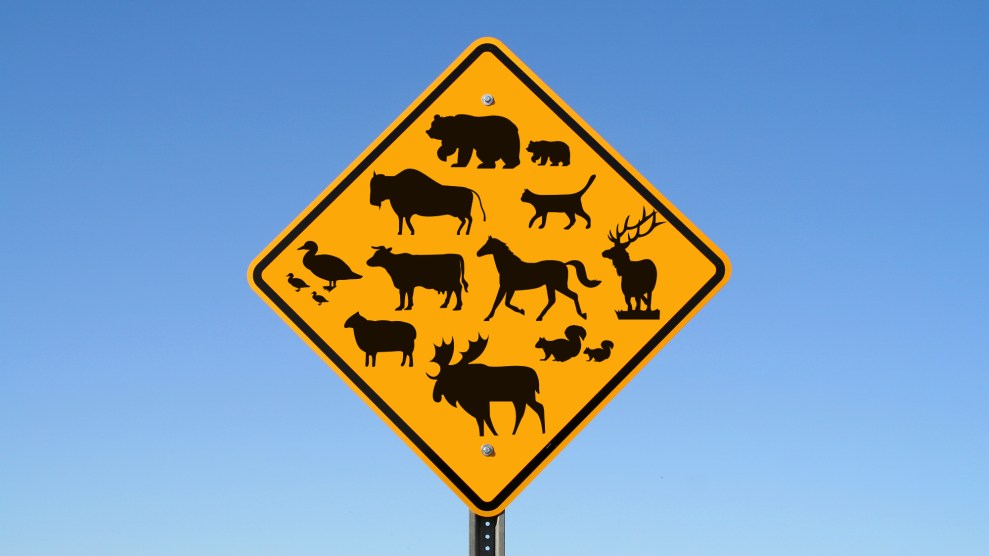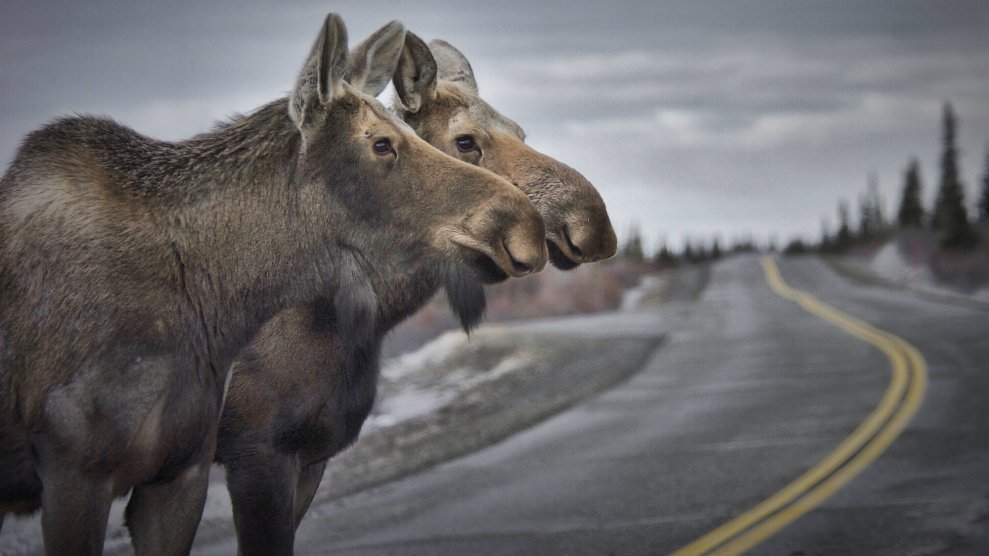
Mother Jones; Getty
As perilous as it is for you to ride in a vehicle, cars may be even more treacherous for wild animals on the road. “It has never been more dangerous to set paw, hoof, or scaly belly on the highway,” writes science journalist Ben Goldfarb in his new book, Crossings: How Road Ecology Is Shaping the Future of Our Planet. The book is teeming with horrifying statistics: More birds die every week on US roads than were killed by the Deepwater Horizon oil spill; each year, frogs are squished by the millions; in New York alone, a deer collision occurs every eight minutes. And, it’s getting worse—as many as 12 percent of land-dwelling mammals end up dying on the road, four times what it was 50 years ago.
Yet, as an environmental concern, America’s roadkill problem has largely been kicked to the, well, curb. “Name your environmental ill—dams, poaching, megafires—and consider that roads kill more creatures with less fanfare than any of them,” Goldfarb writes. In part, he says, that’s because of roads’ ubiquity, or more specifically, their normal-ness. “Their impacts have gone understated both by journalists and, until relatively recently, by conservation groups,” he tells me.
And while human car deaths in the US number around 40,000 every year, we put up with that risk in exchange for fast, convenient travel—that is, freedom. America’s animals are afforded no such luxury. “Even as roads encourage human mobility, they do the precise opposite for wild animals,” Goldfarb says. “They curtail animal migration and mobility and movements.” That tension is what Crossings is about, he says.
The book also sheds light on possible solutions. Wildlife crossings like overpasses and underpasses have been shown to dramatically cut down on animal collisions. Take one example from Wyoming: In the early 2000s, officials installed a series of underpasses in Nugget Canyon, near the Utah border. “Roadkill plunged, from almost ten victims monthly to fewer than two,” Goldfarb writes. Road ecologists estimated that the underpasses prevented 95 wildlife-vehicle crashes per year. This wasn’t just good for animals. In economic terms, that was a savings of at least $627,000 in human pockets, in avoided hospital visits and car repairs. “Crossings weren’t lavish expenditures; they were downright thrifty,” he writes.
They’re also extremely popular. In today’s polarized world, Goldfarb tells me, “it’s so difficult to get anybody to agree on anything, especially when it comes to environmental issues and conservation interventions.” Wildlife crossings are an exception; by some estimates, more than 80 percent of residents in western states such as Colorado, New Mexico, and Nevada favor the installations.
Crossings, out this week, is Goldfarb’s second book, after Eager: The Surprising, Secret Life of Beavers and Why They Matter (a book, I argued last year, that was in part responsible for the rodents’ long overdue rebrand as environmental heroes). In a way, the two books are odd cousins. As Goldfarb and I discussed last week, both beavers and humans are builders, with one critical difference: “Beavers build in ways that are beneficial to all other life on Earth,” he tells me, “whereas our construction tends to be really detrimental to all other life on Earth.”
While that may sound bleak, Crossings is at times surprisingly funny. When we spoke, I asked Goldfarb about his love for long road trips and finding moments of joy in reporting about roadkill. You can read an edited and condensed version of our conversation below:
Why roads? Of all the environmental ills to focus on, why this one?
Roads are largely underappreciated as an environmental impact. Think about how much has been written about climate change, for example, and obviously, rightfully so. But when you think about the forces that are destroying biodiversity right now, roads are—their impacts are enormous. And because they’re such ubiquitous parts of our daily lives, they’re kind of invisible to us. There are so many [conservation] groups focused on climate change and poaching and deforestation, and roads touch all of those other environmental impacts. As I say in the book, they’re the routes—r-o-u-t-e-s—of all evil; they facilitate all of those other ecologically devastating activities.
Roadkill, you write, is a very visible environmental problem. As a kid, for instance, I remember seeing in my neighborhood a dead cat that had been just squished by a car, eyes bulging out. That image has stuck with me my entire life. Do you think that’s helped make this a bipartisan environmental issue? That unlike, say, climate change, people see it in their own daily lives?
In a lot of respects, roadkill is the way in which we interact with nature. If I had to guess, I would say that more Americans have seen a road-killed opossum than an alive one. As that cat was for you, it is viscerally shocking and upsetting when we see it. I’d like to imagine that most people fundamentally care about wildlife, not just for conservation reasons, but because we are fundamentally compassionate toward animals at our core. Even if that fades as we age, I think it’s still within us. Nobody wants to see an animal dead by the road. So yes, I think that the visibility of the problem induces us to care about it.
In the epilogue, you discuss the “Anthropause”—the mass quieting of the world as a result of pandemic lockdowns. How did Covid, if at all, shape your view of roads?
It was kind of an inadvertent experiment: What would happen if we abruptly shut off traffic? And the animal response was amazing. Roadkill rates declined dramatically. Covid revealed how severe roadkill was by abruptly turning it off. Suddenly, when millions of animal lives are being saved by us not driving, you start to think, Wait a second, why are millions of animals dying in the first place?
One point that you touch on a few times is the idea of humans, Homo sapiens, being defined by infrastructure. Like, we are a species that builds stuff—
Just like beavers.
Yes, exactly—like beavers! And while our roads do have negative consequences, like fracturing landscapes, they also can be a source of food for other animals, as you write, like vultures. It made me wonder, philosophically, are roads “nature”?
That’s something eco-philosophers have debated in many different forums for decades. I think that what we do is fundamentally unnatural, in so many ways. And obviously, yes, we are an animal like any other. But we’re also unlike any other in the scale and scope of our construction.
For those species that benefit from roads, like scavenging birds, vultures, and golden eagles, for example, the road is still potentially an ecological trap for them. It lures them in with the promise of carrion, and then it kills them with cars. The road is a habitat in its own right. But it’s also fundamentally and profoundly dangerous.
So much of your book is about roadkill—deer, toads, butterflies, anteaters, the list goes on—yet, it strikes a tone of levity. In writing it, how did you find humor in all of that death?
I think it was something that I was very conscious of on the page. This is going to be, like, the most pretentious, stereotypical, white guy thing but, for much of my adult life, my favorite novelist was David Foster Wallace—I know, embarrassing. I’ve got Infinite Jest on permanent display in my house. It’s such a cliche. But I was actually thinking about him a lot with this book because one thing he does well is write about really dark themes—mental illness and addiction and suicide—using really light, funny prose. And I was thinking the same thing: How do I guide the reader through a dark thematic book that she might not otherwise be able to stomach? I felt like the answer was to try to keep it light and funny on the level of the sentence.
I came away from Crossings with a feeling of optimism. Maybe, as we’ve become more aware of our own destruction, we’re able to do something about it. Did you intend for that feeling—for that sense of agency?
It’s difficult because there are no perfect solutions, right? It’s easy to say, for example, “We need to improve mass transit.” And, certainly, that’s the case. We need to get people out of cars. But I live in rural Colorado, and it’s pretty hard to imagine the public transportation infrastructure that would get people out of their cars here.
Wildlife crossings are another kind of imperfect solution. They’re very helpful in that they tackle certain problems—they reduce roadkill and they allow animal migrations to continue on either side of the highway. But they don’t address road noise or tire particulates or road salt being indiscriminately applied and changing the chemistry of [the environment].
There are all these different solutions out there. And they all address small pieces of the problem. But there is no single solution. So it’s interesting that you ultimately felt that the book was optimistic because that’s not always how I feel.
Throughout the book, you seem to grapple with your own use of roads. You write, for instance, that you enjoy long road trips. But as you said, roads may be “the routes of all evil.” Did this conflict shape the book?
That conflict profoundly shaped the book. One of the things that I was very conscious of was not being ‘holier than thou’ and lecturing my readers, because I drive a lot. I don’t have a daily commute, but I use my car several times a week to access these natural places that I love. I am part of the problem. Just a couple of nights ago, I hit an owl driving back from a hiking trip and felt, of course, miserable about it. I am complicit.
I think about road ecology in kind of the same terms as climate change. For a long time, I think the environmental movement was very focused on changing people’s individual behavior, the ultimate symbol of that being, If we all just change our light bulbs, we’re going to solve climate change. And, of course, that wasn’t effective, right? Both because individual behavior isn’t really the scale at which you need to tackle the problem, and also because, when you just nag people about their light bulbs you can turn [the people] off. I think road ecology is similar. If I wrote a book that just hectored people about their driving habits, I’d be unlikely to change their minds.
I truly believe that getting individual Americans to stop driving isn’t particularly realistic. What we really need is systemic change, whether that’s better mass transit or more wildlife crossings. We need to solve this problem at an infrastructure level, rather than at the individual behavior level.













